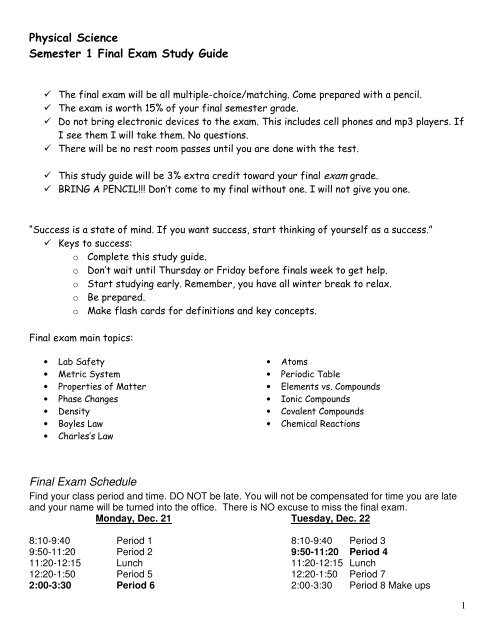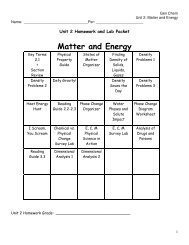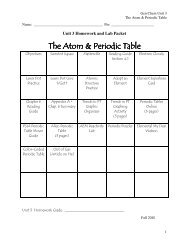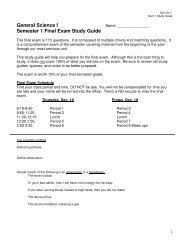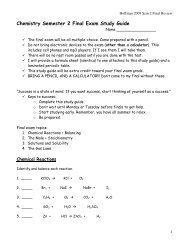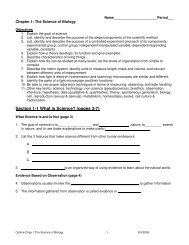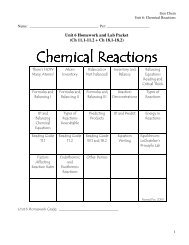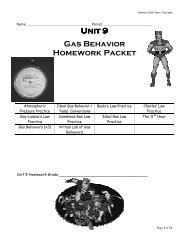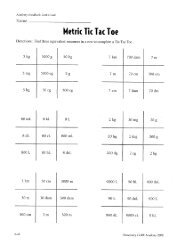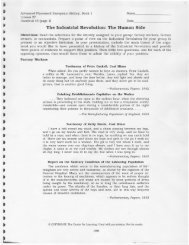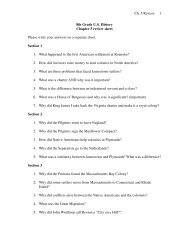Physical Science Sem ester 1 Final Exam Study Guide Final Exam ...
Physical Science Sem ester 1 Final Exam Study Guide Final Exam ...
Physical Science Sem ester 1 Final Exam Study Guide Final Exam ...
- No tags were found...
Create successful ePaper yourself
Turn your PDF publications into a flip-book with our unique Google optimized e-Paper software.
! "" " # $ % ! & ' "$ ( ) *+$ ",--- . " /0 " 1# 2 34o o . 5 # o 0 ' 1 # o & o 6 # #5 4• ,0 • 6 0 • *6 • *• • & , • ., • ) • * • + • " • • ' <strong>Final</strong> <strong>Exam</strong> ScheduleFind your class period and time. DO NOT be late. You will not be compensated for time you are lateand your name will be turned into the office. There is NO excuse to miss the final exam.Monday, Dec. 21 Tuesday, Dec. 228:10-9:40 Period 1 8:10-9:40 Period 39:50-11:20 Period 2 9:50-11:20 Period 411:20-12:15 Lunch 11:20-12:15 Lunch12:20-1:50 Period 5 12:20-1:50 Period 72:00-3:30 Period 6 2:00-3:30 Period 8 Make ups1
Lab Safety and the Scientific Method1. What are 5 important lab safety rules?2. In your own words, define independent variable.3. In your own words, define dependent variable.4. Classify the following observations as qualitative or quantitative._____________________________ ____________________________The post office is really far away.Crow Creek Park is 2 miles awayI ate a lot of rice crispy treats.The flame is 475 o CThe flame is blue with orange spots. The pond is 6.8m deepThe oven is hot.The CD costs $11.995. What do quantitative observations have in common?6. What do qualitative observations have in common?7. What unit are the following measurements taken in? What tool is used to measure them?Temperature _______________; _____________________Length _______________; _____________________Volume _______________; _____________________Mass _______________; _____________________Metric Conversions8. Convert these unitsa. 48 DL = _______________ mLb. 0.01 cL = _______________ Lc. 3.04 m = _______________ dmd. 0.0023 kg = _______________ mge. 100 mm = _______________ mf. 0.055 Kg = _______________ gg. 4000 mL = _______________ Lh. 638 mg = _______________ g2
Properties of Matter9. What is a Solid?10. What is a liquid?11. What is a gas?12. What is an Element?13. What is a Compound?14. What is a homogenous Mixture? Give 2 <strong>Exam</strong>ples15. What is a heterogeneous Mixture? Give 2 <strong>Exam</strong>ples16. What is a physical change? Give 2 <strong>Exam</strong>ples17. What is a chemical change? Give 2 <strong>Exam</strong>ples18. What are 3 clues that indicate that a chemical change has occurred?19. Determine whether the following is a physical change or chemical change.Slicing a pizzaBreaking a windowMelting water at 0 o CA firework explodingBurning wood_______________________________________________________________________________3
Directions: Complete each sentence or statement using the word bank provided. All of the words willbe used and none will be used more than onceSolid Increase Element.Liquid Decrease CompoundGas Temperature <strong>Physical</strong>Homogeneous Heterogeneous ChemicalMelting Boiling Pressure20. Pure substances are either _________________________ or___________________________.21. The substances in a(an) _________________________ mixture are evenly spread out throughoutthe mixture.22. A(an) __________________________ does not have a definite volume or a definite shape.23. A(an) ________________________ change happens when a material changes shape or size butnot the atomic structure of the material.24. _________________________ properties can be observed only when the substance changesinto a different substance.25. A(an) __________________________ has a definite volume and a definite shape.26. Lowering the volume of a gas ______________________ its pressure if the______________________ of the gas stays the same.27. A(an) __________________________ has a definite volume but does not have a definite shapeDensity, Boyles Law, Charles LawEquations: d=m/v28. A block of aluminum has a volume of 15.0 mL and weighs 40.5 g. What is its density?Givens:Equation: Substitution: Answer with Units:4
29. Mercury metal is poured into a graduated cylinder that holds exactly 22.5 mL. The mercury usedto fill the cylinder weighs 306.0 g. From this information, calculate the density of mercury.Givens:Equation: Substitution: Answer with Units:30. Calculate the mass of a liquid with a density of 3.2 g/mL and a volume of 25 mL.Givens:Equation: Substitution: Answer with Units:31. State Boyle’s Law and give a real-life example of it at work.32. State Charles’ Law and give a real-life example of it at work.33. What is pressure?34. What is volume?35. In a flexible container, when the temperature of a gas increases, the volume of the gas willincrease. _________________________ (true or false)36. According to Charles’s law, whenever the temperature of a gas at constant pressure decreases,the volume ____________________ (increases or decreases).37. When the temperature of a gas in a balloon increases, the volume of the balloon will____________________. (increases or decreases)38. Weather balloons are filled with only a small amount of helium because the____________________ of the balloon will increase as the air pressure decreases at higheraltitudes. (volume, temperature, pressure)39. In a rigid container, when the speed of the gas molecules decreases, the____________________ of the gas also decreases. (volume, temperature, pressure)5
40. Use the diagram to answer each question. (Volume units in diagram are Liters and Air Pressureunits are kPa) Each question is worthA) What pattern in the behavior of gases is shown from Step 1 through Step 3 of the figure? In otherwords, what happens to volume and pressure?B) What is the name of the scientific law illustrated by this diagram? State the law and thensummarize that law.C) Predict what would happen to the volume of the gas if the pressure in Step 3 was increased from400 kPa to 800 kPa.D) Explain what would happen in Step 2 if the cylinder was heated while the plunger was held steady.6
Phase Changes41. What is a phase change?42. On the graph below, label the following:SolidMeltingLiquidEvaporationGasCondensationFreezing43. What is happening to the molecules during each of the following phase changes? For each, say ifthe molecules are speeding up or slowing down and are they moving apart or getting closertogether.Melting:Condensation:Evaporation:FreezingAtoms & Periodic Table44. What is an Atom?45. Describe the general structure of an atom.7
46. Complete the Following ChartWhere are theyfound?ProtonsDo they have amass?What is theircharge?NeutronsElectrons47. Atomic Number = Atomic Mass - ________________________48. Atomic Mass = ___________________+_________________________49. The rows going across the periodic table are known as:50. The columns going up and down on the periodic table are called:8
51. Directions: Label the following on the Periodic Table BelowMetalsNon-MetalsRare Earth MetalsHalogensAlkaline Earth MetalsNoble GasesTransition MetalsMetalloidsAlkali MetalsMost Reactive MetalGroup with 5 Valence Electrons52. What is an Ion?53. What is an Isotope?9
54. Directions: Answer the following questions using your knowledge of the atom andits structure.Element Symbol Atomic # Mass # Protons Neutrons ElectronsBa 13644 32235 143Rb 37 35Iodine 127 53Ionic and Covalent Bonds55. Fill in the Following ChartType of Bond Share orTransferelectrons?CovalentBondbetweenwhat types ofelements?What isformed, acompound ora molecule?List oneproperty ofthis bond.Ionic56. Write the formula or the name the following compounds and indicate if it’s a ionicor covalent bond.Name Formula Type of BondSodium bromideN 2 O 5Barium nitrideDicarbon hexahydride10
NaClP 3 O 7Nitrogen trihydridePotassium chlorideMgCl 2N 2 ONitrogen dioxideChemical Reactions57. What are products?58. What are reactants?59. What is the Law of Conservation of Mass?60. 3 Fe + 4 H 2 O → Fe 3 O 4 + 4 H 2LeftFeHORightYesBalanced?No11
61. Cl 2 + 4 NaBr → 2 NaCl + 2 Br 2LeftClNaBrRightYesBalanced?No62. Al 2 (SO 4 ) 3 + 3 Ca(OH) 2 → 2 Al(OH) 3 + 3 CaSO 4LeftAlSO 4CaOHRightYesBalanced?NoDirections: Identify what type of reaction is seen in the following equations: singlereplacement, double replacement, synthesis, decomposition, or combustion. Then,balance the equations in #63, 65, 67, 68, and 69.63. _____ HgO Hg + O 264. _____ NaCl + AgNO 3 NaNO 3 + AgCl65. _____ Mg + HCl MgCl 2 + H 266. _____ C 6 H 12 O 6 + O 2 CO 2 + H 2 O67. _____ NaOH + H 2 SO 4 Na 2 SO 4 + HOH68. _____ Al 2 (SO 4 ) 3 + Ca(OH) 2 Al(OH) 3 + CaSO 469. _____ H 2 + O 2 H 2 O70. What is a catalyst?12


